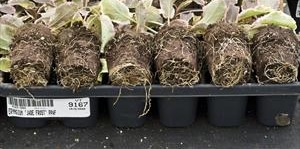Shop by Category
Shop by Brand
Shop by Brand
Eryngium
Striking Blue Blooms
- Unique Architectural Beauty: Eryngium's spiky, metallic-blue flowers and bracts create a dramatic and eye-catching display.
- Pollinator Friendly: Attracts bees, butterflies, and other beneficial insects to your garden.
- Drought Tolerant: Thrives in sunny, dry conditions, making it perfect for low-maintenance gardens.
- Excellent Cut Flowers: Long-lasting blooms that add a distinctive touch to floral arrangements.
- Deer Resistant: The prickly nature of the plant deters deer.
- Planting:
- Plant in well-drained, sandy soil.
- Choose a location with full sun.
- Space plants according to their mature size, typically 12-18 inches apart.
- The best times to plant are in the spring or fall.
- Growing:
- Water regularly until the plants are established.
- Once established, Eryngium is highly drought-tolerant and requires minimal watering.
- Deadhead spent flowers to encourage further blooming.
- Taller varieties may require staking to prevent them from flopping over in windy conditions.
- It is possible to divide clumps every few years to reinvigorate the plants.
Additional Considerations:
- Eryngium is a hardy perennial that can withstand a range of temperatures.
- It is important to ensure good drainage to prevent root rot.
- When handling the plant, be mindful of the spiky bracts.
- There are a variety of Eryngium species, so be sure to choose one that is suitable for your climate and garden conditions.
 Eryngium (ee-rin-jee-um) Sea Holly, Apiaceae Family. Eryngiums are handsome and imposing in the border or the rock garden. They have globe-shaped flower heads, usually blue. Eryngium are decorative either fresh or dried, and seed pods can be used for winter arrangements. Developed for the cut flower industry, Eryngium makes an excellent addition to the home garden.
Eryngium (ee-rin-jee-um) Sea Holly, Apiaceae Family. Eryngiums are handsome and imposing in the border or the rock garden. They have globe-shaped flower heads, usually blue. Eryngium are decorative either fresh or dried, and seed pods can be used for winter arrangements. Developed for the cut flower industry, Eryngium makes an excellent addition to the home garden.
The plants need full sun and sandy garden soil, well-drained with plenty of moisture. Tolerant of poor soils, if Eryngium is placed in very rich soil or less than full sun, tall plants may sprawl. This is a taprooted plant that transplants poorly and is best left undisturbed once established.
